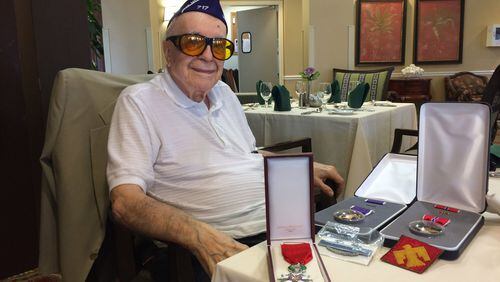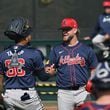Jerry Halpern was 12 years old when his family came to America after fleeing Nazi Germany in 1937. Six years later, he was fighting in the U.S. Army against his former countrymen.
After he enlisted, he was assigned as a machine gunner in the U.S. Army's 45th Infantry Division. He landed on the beach at Anzio in Italy to replenish the thousands of Allied troops lost in prolonged fighting there and, with his division, helped liberate Rome, 30 miles to the north, the day before D-Day.
He saw combat again at Saint-Tropez, France, where he came ashore in the sixth assault wave. It was there that he was wounded in his right arm, earning a Purple Heart, he said.
Halpern wanted to continue, but a lieutenant colonel put him on a truck to the evacuation hospital.
“I still remember saying, ‘Hand me my .45. I’ll carry it in my left hand,’” the 91-year-old recalled Friday before being honored with about 40 other veterans living at La Posada, a senior community in Palm Beach Gardens, Florida.
The injury marked the end of his fighting days. He spent about three months off and on recuperating in the hospital in England. When he was released, he was on limited assignment in France.
He never told his fellow soldiers of his German heritage, and he was able to speak English without an accent by that time. Halpern also earned a Bronze Star, Combat Infantry Badge and French Legion of Honor Medal.
After his service, he became an attorney and spent six years living as an expat in Paris. He went back to school and joined the faculty at the University of Arkansas, where he stayed for 20 years.
Fellow World War II veteran Gene Starn, also a resident of La Posada, refers to his friend as a hero. The Army decided during basic training that Starn had “dust pneumonia,” an allergy to the green dye used in the uniform.
He was assigned to do office work and went through the Army Specialized Training Program at the University of Maryland, where he became a journalist for The Diamondback student newspaper.
He had his heart set on joining The Stars and Stripes, the daily newspaper serving the military, but he didn’t get an acceptance letter until he was on a ship in the Pacific.
Starn trained in the Detroit area to be a tank engine mechanic and was then sent to Virginia to do maneuvers. But, he said, the Army forgot the tanks.
While they were en route to New Guinea, an Army mix-up caused them to be mistaken for refrigeration mechanics, he said. They were sent to repair Gen. Douglas MacArthur’s air conditioning and then to maintain refrigerators that stored food for the troops.
Occasionally, Japanese soldiers who wanted to surrender would walk up to the Americans and sit down next to them while they were watching outdoor movies.
“That’s the closest I came to seeing the so-called enemy of the war,” Starn said.
He was on a hospital ship recovering from surgery to have a kidney removed when the atomic bombs were dropped, effectively ending the war with Japan.
Starn became a broadcast journalist when television news was just becoming a reality and then ran an aluminum extrusion business in Denver that allowed him to retire at the age of 50.
He and Halpern were able to go on an Honor Flight to Washington, D.C., where they saw the war memorials and the Changing of the Guard at Arlington National Cemetery together.
About the Author






